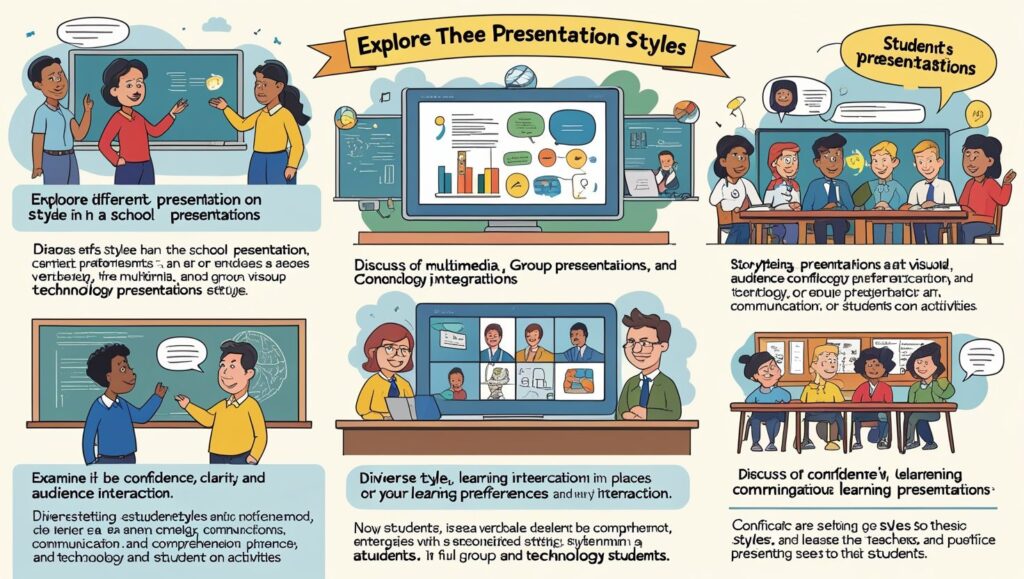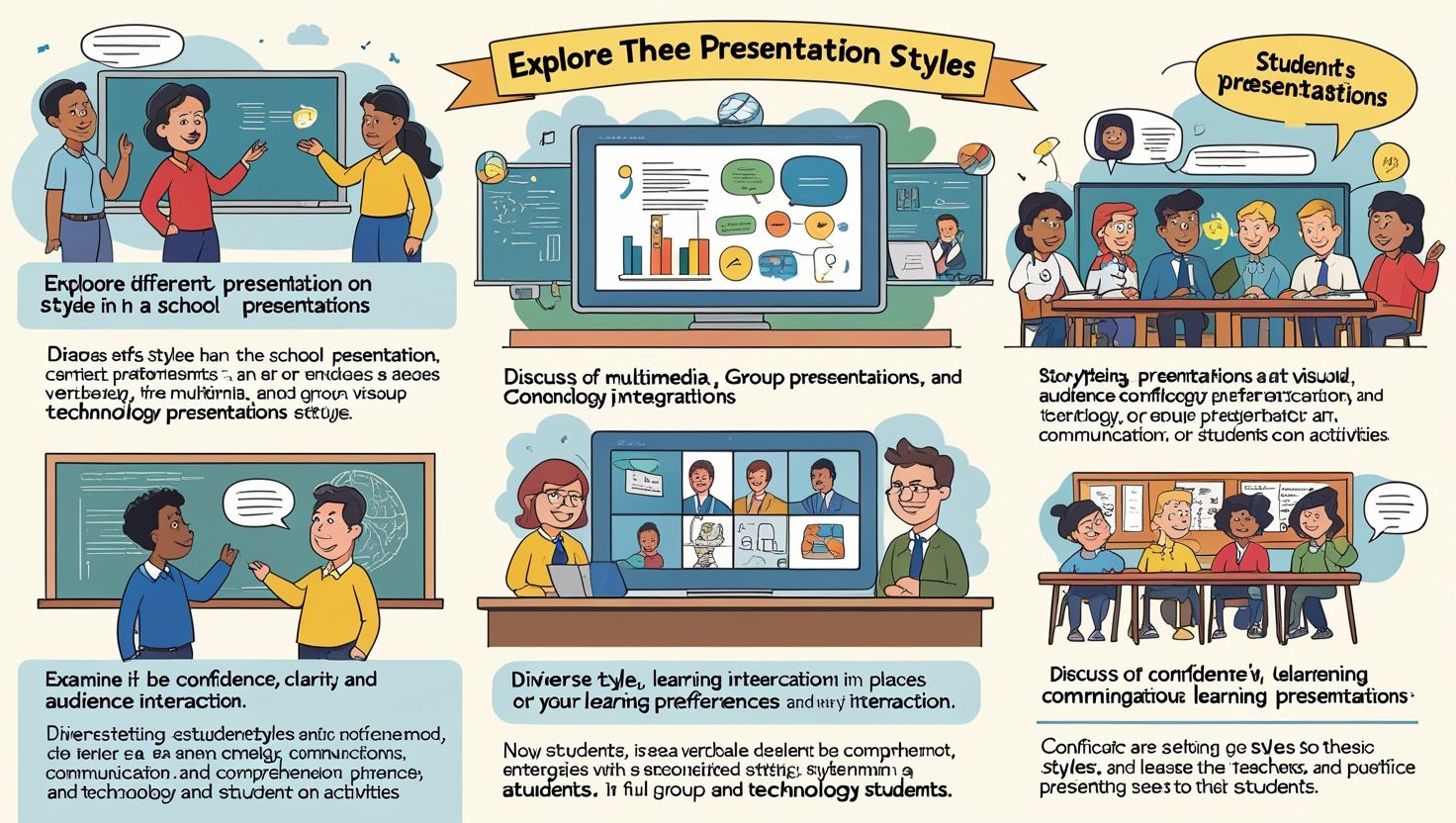Presentation Styles in a School Setting, In the modern educational landscape, presentations have become an integral part of the learning process. They serve as a platform for students to express their ideas, demonstrate their understanding of a subject, and develop essential communication skills. In schools, presentations are not just limited to students; teachers also use them to deliver lessons, share information, and engage their classes. The effectiveness of a presentation often hinges on the style chosen, as different styles cater to various audiences, objectives, and content types. This article explores the various presentation styles commonly used in schools, their benefits, and how they can be effectively implemented to enhance learning outcomes.
1. Formal Presentations
Formal presentations are structured and often follow a specific format. They are commonly used in academic settings, such as during exams, debates, or when presenting research projects. This style is characterized by a clear introduction, body, and conclusion, with a focus on delivering information in a professional and organized manner.
Key Features:
- Use of visual aids like PowerPoint slides or charts.
- Emphasis on factual accuracy and evidence-based arguments.
- Limited interaction with the audience during the presentation.
Benefits:
- Helps students develop critical thinking and research skills.
- Encourages clarity and precision in communication.
- Prepares students for professional environments where formal presentations are often required.
Example: A student presenting a science project on renewable energy sources, complete with data, graphs, and a well-structured argument.
2. Interactive Presentations
Interactive presentations are designed to engage the audience actively. This style is particularly effective in classrooms, as it encourages participation and fosters a collaborative learning environment. Teachers often use this style to break the monotony of traditional lectures and keep students engaged.
Key Features:
- Use of questions, polls, or quizzes to involve the audience.
- Incorporation of group activities or discussions.
- Reliance on multimedia tools like videos, animations, or interactive whiteboards.
Benefits:
- Enhances student engagement and retention of information.
- Promotes teamwork and communication skills.
- Allows for immediate feedback and clarification of doubts.
Example: A history teacher using an interactive timeline to teach students about World War II, pausing at key events to ask questions or initiate discussions.
3. Visual Presentations
Visual presentations rely heavily on images, videos, and other visual elements to convey information. This style is particularly effective for younger students or visual learners who may struggle with text-heavy content. It is also useful for explaining complex concepts that are easier to understand when represented visually.
Key Features:
- Use of infographics, diagrams, and photographs.
- Minimal text, with a focus on visual storytelling.
- Incorporation of videos or animations to demonstrate processes or ideas.
Benefits:
- Appeals to visual learners and makes content more accessible.
- Simplifies complex ideas and makes them easier to understand.
- Enhances creativity and encourages students to think outside the box.
Example: A biology teacher using a 3D model of the human heart to explain its structure and function.

4. Storytelling Presentations
Storytelling is a powerful presentation style that uses narratives to convey information. This approach is particularly effective in subjects like literature, history, and social studies, where stories can bring concepts to life and make them more relatable.
Key Features:
- Use of anecdotes, personal experiences, or fictional stories.
- Emphasis on emotional engagement and relatability.
- Incorporation of dramatic elements like tone variation and gestures.
Benefits:
- Makes content more memorable and engaging.
- Helps students connect emotionally with the subject matter.
- Encourages creativity and imagination.
Example: An English teacher narrating a short story to illustrate the use of literary devices like metaphors and similes.
5. Demonstrative Presentations
Demonstrative presentations involve showing how something is done or how it works. This style is commonly used in science labs, art classes, or vocational training, where hands-on learning is essential.
Key Features:
- Step-by-step demonstration of a process or technique.
- Use of physical props or tools.
- Emphasis on practical application and observation.
Benefits:
- Provides a clear understanding of practical skills.
- Encourages active participation and hands-on learning.
- Helps students retain information through experiential learning.
Example: A chemistry teacher demonstrating a titration experiment to show how acids and bases react.
6. PechaKucha Presentations
PechaKucha is a unique presentation style that originated in Japan. It involves presenting 20 slides, each displayed for 20 seconds, resulting in a concise and fast-paced presentation. This style is gaining popularity in schools as it encourages students to be concise and focused.
Key Features:
- Strict time limits for each slide.
- Emphasis on brevity and clarity.
- Use of minimal text and impactful visuals.
Benefits:
- Develops time management and prioritization skills.
- Encourages creativity in condensing information.
- Keeps the audience engaged with a dynamic pace.
Example: A student presenting a PechaKucha on climate change, using striking images and concise points to convey the urgency of the issue.
7. Collaborative Presentations
Collaborative presentations involve multiple presenters working together to deliver a single presentation. This style is often used for group projects or team-based assignments, where students must coordinate and divide responsibilities.
Key Features:
- Division of content among team members.
- Seamless transitions between speakers.
- Emphasis on teamwork and coordination.
Benefits:
- Promotes teamwork and collaboration skills.
- Allows for diverse perspectives and ideas.
- Reduces the pressure on individual presenters.
Example: A group of students presenting a joint project on sustainable urban planning, with each member covering a specific aspect like transportation, housing, or green spaces.
8. Informal Presentations
Informal presentations are less structured and more conversational in nature. They are often used in casual settings, such as classroom discussions or peer-to-peer sharing sessions. This style encourages spontaneity and open communication.
Key Features:
- Relaxed tone and informal language.
- Greater interaction with the audience.
- Flexibility in content delivery.
Benefits:
- Creates a comfortable and inclusive environment.
- Encourages open dialogue and idea sharing.
- Helps students overcome the fear of public speaking.
Example: A student sharing their personal experience with a community service project during a class discussion.
Choosing the Right Presentation Style
The choice of presentation style depends on several factors, including the audience, the subject matter, and the objectives of the presentation. For instance, a formal presentation may be more suitable for a science fair, while an interactive presentation might work better for a classroom lesson. Teachers and students should consider the following when selecting a style:
- Audience: Younger students may respond better to visual or storytelling presentations, while older students may appreciate more formal or collaborative styles.
- Content: Complex topics may require demonstrative or visual presentations, while abstract concepts may benefit from storytelling or interactive approaches.
- Objectives: If the goal is to inform, a formal or visual presentation may be appropriate. If the goal is to engage, an interactive or collaborative style might be more effective.
Tips for Effective Presentations in Schools
Regardless of the style chosen, there are some universal tips that can help make presentations more effective:
- Know Your Audience: Tailor the content and delivery to suit the age, interests, and knowledge level of the audience.
- Practice: Rehearse the presentation multiple times to build confidence and ensure smooth delivery.
- Use Visual Aids Wisely: Visual aids should complement the presentation, not overwhelm it. Keep them simple and relevant.
- Engage the Audience: Use questions, anecdotes, or interactive elements to keep the audience involved.
- Be Concise: Avoid unnecessary details and focus on the key points to maintain the audience’s attention.
- Seek Feedback: After the presentation, ask for feedback to identify areas for improvement.
Conclusion
Presentation styles in schools are as diverse as the students and teachers who use them. From formal and visual presentations to interactive and storytelling approaches, each style offers unique benefits and can be tailored to suit different learning objectives. By understanding and experimenting with these styles, educators and students can create more engaging, effective, and memorable presentations. Ultimately, the goal is not just to convey information but to inspire curiosity, foster collaboration, and develop essential communication skills that will serve students well beyond the classroom.

3 thoughts on “Presentation Styles in a School Setting”
Comments are closed.